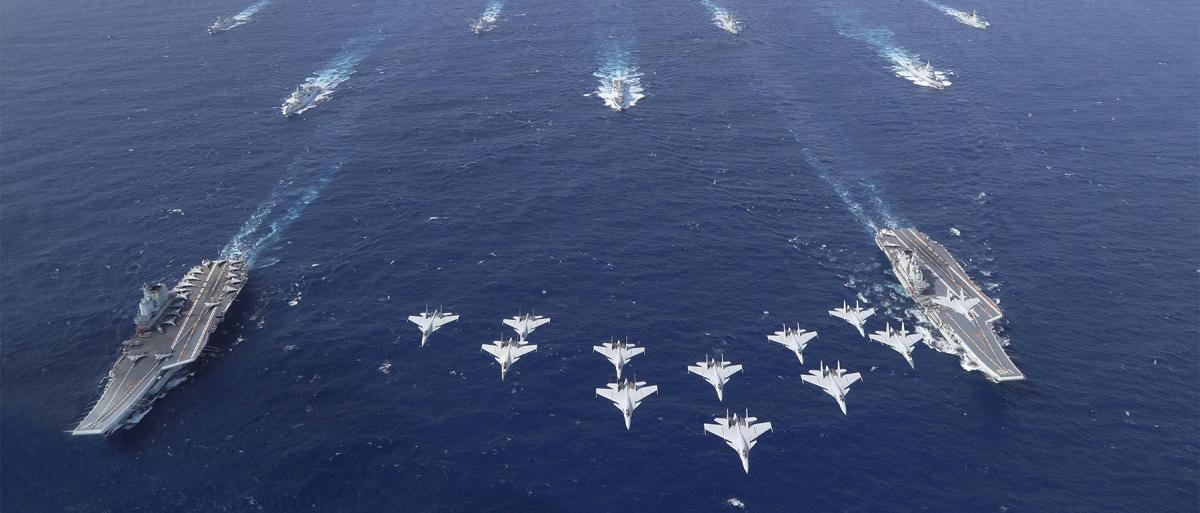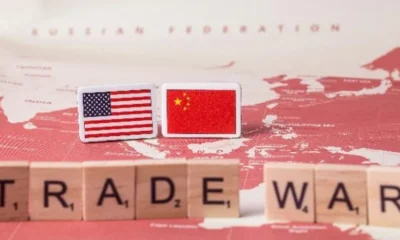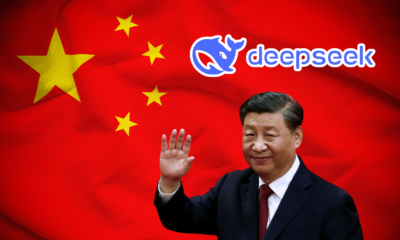Politics
Threat Level ‘Severe’ Says Taiwan In Response To China’s Largest Naval Fleet Prescence In The Region In Decades. Did United States Latest Military Aid Contribute To This Escalation?
Published
10 months agoon

In an unusual show of maritime strength, China has dispatched its largest naval fleet in regional waters in nearly three decades, according to Taiwan’s Ministry of Defense.
The scale and positioning of this deployment are raising alarms, particularly given the tensions surrounding Taiwan, a democratically governed island that China claims as its own. Could recent U.S. military aid to Taiwan and heightened geopolitical tensions have contributed to this escalation?
A Display of Power
The Taiwanese defense ministry described the current deployment as the most significant since China conducted war games in the lead-up to Taiwan’s 1996 presidential elections. The fleet is operating in a vast area stretching from Japan’s southern islands to the South China Sea, illustrating its strategic reach.
Defense ministry spokesperson Sun Li-fang stated that despite no official announcements from China about military drills, the scale of the naval activities poses a “great threat.” Taiwan’s military raised its alert on Monday in response to China reserving airspace and deploying naval and coast guard vessels near the island.
Senior intelligence officer Hsieh Jih-sheng noted that while no live-fire drills have been observed, there is a marked increase in activity near Taiwan, particularly in the northern regions. Approximately 90 Chinese navy and coast guard ships are currently operating in the area, an alarming figure that signals an intensification of China’s regional ambitions.
Hsieh pointed out that China’s deployment appears aimed not just at Taiwan but at other countries in the First Island Chain, a strategic maritime corridor encompassing Japan, Taiwan, the Philippines, and Borneo. This positioning aligns with China’s broader goal of area denial, aiming to deter foreign intervention, particularly from the United States and its allies.

Is Taiwan’s Strait Becoming Beijing’s Internal Sea?
China is building what experts describe as two “walls” in the region: one at the eastern edge of Taiwan’s Air Defense Identification Zone (ADIZ) and the other extending further into the Pacific. According to Taiwan’s Ministry of Defense, these deployments are part of a broader strategy by China to assert control over the Taiwan Strait, aiming to turn it into what Taiwan perceives as an “internal sea” of China.
Hsieh Jih-sheng, a senior Taiwanese military intelligence officer, explained that China’s actions are designed to send a clear and simple message: the Taiwan Strait is increasingly being viewed as part of China’s territorial waters. This aggressive positioning is compounded by the rapid increase in military activity around Taiwan, signaling heightened threats in the region.
Taiwan’s defense ministry reported on Tuesday that over the previous 24 hours, Chinese military aircraft, naval vessels, and coast guard ships had been actively operating near the island. In total, 47 military aircraft were detected in the surrounding airspace, with the majority flying in zones to the north of Taiwan, near China’s Zhejiang province, and others in the Taiwan Strait and southwest of Taiwan.
Of particular concern is the simulation of attacks on foreign naval vessels and the practice of pushing away military and civilian aircraft, which a senior Taiwanese security source described as part of a “blockade exercise” by China. These actions suggest that China is preparing for a larger confrontation and is testing Taiwan’s defenses under increasing pressure.
Taiwan’s Defiance and the latest U.S. Military Aid Escalate China’s Move?
Despite these rising tensions, Taiwan’s government remains firm in its stance against Beijing’s claims. Taiwan President Lai Ching-te and his administration continue to reject China’s sovereignty over the island, insisting that the people of Taiwan alone have the right to determine their future.
This defiance has not only deepened Taiwan’s estrangement from Beijing but also drawn the United States into the fray, particularly with ongoing military support to Taiwan.
In response to China’s growing threat, the United States recently approved a substantial military aid package for Taiwan. Announced on November 29, the deal, valued at approximately $385 million, includes spare parts for Taiwan’s F-16 fleet, radar systems, and other military equipment.
The Pentagon emphasized that the sale is essential to maintaining Taiwan’s defense readiness and bolstering its self-defense capabilities in the face of growing Chinese aggression.
This new military support comes just weeks after a $2 billion arms package approved in late October, which included advanced surface-to-air missile systems. The aid package also coincides with Taiwan President Lai’s Pacific tour, which included stops in U.S. territories Hawaii and Guam, areas heavily criticized by China for hosting high-level diplomatic visits.
)
Heightened Tensions in the Indo-Pacific
This latest round of military support for Taiwan comes at a time of escalating tensions in the Indo-Pacific region. Beijing has repeatedly warned the United States to avoid crossing its “red line” on Taiwan, framing the issue as a matter of China’s “core interests.” The U.S. response, however, has been to reaffirm its commitment to Taiwan’s security, maintaining its stance that the island’s defense is crucial to regional stability.
China has once again voiced strong opposition to U.S. involvement in Taiwan’s affairs, particularly criticizing the recent U.S. approval of military aid to the island and Taiwan President Lai Ching-te’s diplomatic travels.
Speaking on behalf of China’s Foreign Ministry, spokesperson Mao Ning condemned Lai’s trip through the United States, labeling it a violation of the “One China” principle and accusing Washington of supporting “Taiwan independence” separatists. This follows a familiar narrative from Beijing, which has consistently sought to curtail international recognition of Taiwan and any actions that could bolster its autonomy.
The U.S. Stance on Taiwan
While the U.S. officially adheres to the “One China” policy, which recognizes Beijing over Taipei, the Taiwan Relations Act (TRA) of 1979 mandates U.S. support for Taiwan’s defense. The TRA obliges the U.S. to provide Taiwan with arms of a defensive nature and maintain the capacity to prevent any coercion or military force against Taiwan. This legal framework has allowed for the continued U.S. military presence in the region, despite the diplomatic shift to China.
U.S. House Foreign Affairs Committee announced the formation of a task force aimed at accelerating military sales to overseas clients, including Taiwan. As part of this effort, the U.S. is providing Taiwan with advanced military hardware, including MQ-9 drones, Patriot and NASAMS air defense systems, F-16 Viper fighter jets, HIMARS rocket launchers, and Abrams Main Battle Tanks (MBTs).
Amid these escalating tensions, military analysts and U.S. commanders have warned that China is preparing for all-out combat, with some speculating that Beijing could launch an invasion of Taiwan as early as 2027. China’s military buildup, coupled with its increasingly aggressive stance, has raised alarms in the U.S. and among its allies.
China views Taiwan as a breakaway province that must eventually be reunified with the mainland, even by force if necessary. In response to U.S. arms sales, China has frequently stated that such actions violate its sovereignty and territorial integrity, accusing Washington of exacerbating tensions and turning Taiwan into a “powder-keg” nation.
Earlier this year, China condemned the U.S. arms sales, claiming they “seriously interfere” in China’s internal affairs and threaten the stability of the Taiwan Strait. Beijing’s anger is further fueled by the recent announcement of U.S. military plans for contingency operations in the region.
Missile Basing Reports Heighten Friction
Further aggravating the situation, reports surfaced in late November suggesting that the U.S. and Japan are planning to establish temporary military bases and missile units in the Philippines and along Japan’s southwestern Nansei island chain. These bases would be part of a joint action plan aimed at countering China’s growing military presence in the region, particularly regarding Taiwan.
According to sources cited by Kyodo News, the U.S. Marine Littoral Regiment would be stationed along the island chain, equipped with multiple-launch HIMARS systems to respond rapidly to any escalation in the Taiwan Strait. The U.S. military plans to establish temporary bases on inhabited islands in the chain as a contingency measure, should the Taiwan crisis become imminent.
These reports have only added fuel to the fire, with Beijing expressing its deep concerns over what it views as provocative actions by Washington. China has repeatedly warned that any U.S. military presence in Taiwan or its surrounding areas would be a direct challenge to its sovereignty.
The report indicates that the U.S. Army plans to deploy long-range firing units from the Multi-Domain Task Force (MDTF) in the Philippines. The MDTF is designed to operate across multiple domains, including cyber, space, air, land, and maritime environments. In the event of a Taiwan crisis, the U.S. will also utilize its nine military bases in the Philippines to bolster its regional presence.
In the scenario of a Chinese invasion of Taiwan, the U.S. Marine Corps, equipped with HIMARS rocket systems, would be swiftly deployed to the southwestern Japanese islands near Taiwan, which border the East China Sea. Meanwhile, a newly established U.S. Army unit, created partly to prevent China from blocking access to the South China Sea, would be positioned at military bases in the Philippines. If these plans are implemented, it could draw Tokyo, Manila, and Washington into a confrontation over Taiwan.
However, neither Japan nor the Philippines has publicly expressed a willingness to directly join U.S. forces in defending Taiwan against China. The reported deployment strategy has sparked strong criticism from Beijing, which argues that the U.S. is using the Taiwan issue as a pretext to expand its military presence in the region.
In response to the reports, Chinese Foreign Ministry spokesperson Mao Ning emphasized, “The key to maintaining peace and stability across the Taiwan Strait is adhering to the One-China principle. China strongly opposes any country using the Taiwan issue as an excuse to enhance military deployments in the region, increase tensions, and disrupt regional peace and stability.”
The Last Bit
China’s military buildup, including its aggressive naval maneuvers and simulated blockade exercises, coupled with increasing U.S. arms sales, and military precense sets the stage for further volatility in the Taiwan Strait.
Whether these actions are part of China’s broader strategy to assert dominance in the region or a prelude to more direct action remains to be seen. Both Taiwan and the United States will likely remain on high alert, anticipating further provocations from China as the strategic contest for control over the Taiwan Strait intensifies.
The coming months could prove pivotal in determining the future of Taiwan and its security in the face of an increasingly assertive Beijing.
You may like
-


Taiwan’s ‘Historic’ TSMC Deal, A Win Or The End Of Its ‘Silicon Shield’ As China Threatens? A Jittery Taiwan Watches Trump’s Moves On Ukraine, Wondering, Could We Be Next?
-


A Trade War That Just Won’t Quit. As Trump’s Tariffs Hit, China Stays The Course, For Xi’s Its Business As Usual Strategy
-


Indian Stock Market In Turmoil. Investors In Panic Mode, Is This A Temporary Correction Or The Start Of A Bear Market?
-


America And China’s Thirst For Gold In 2025 Is Draining Other Countries’ Reserves; Here’s Why?
-


Shakeup In The Auto Sector. Mercedes-Benz 15% Job Cuts, Nissan CEO Exit, And Germany’s Make-Or-Break Year
-


DeepSeek Ai Rush. China’s AI Contender Gears Up for Next Big Launch Even As It Gets Xi Jinping’s Blessings
